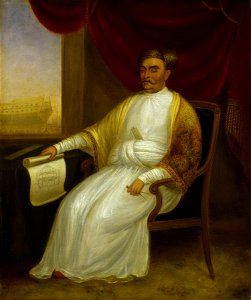Jamsetjee bomanjee wadia, c. 1754-1821
a full-length portrait seated to left in a white robe and embroidered pashmina shawl. He wears a full moustache curled at the ends and a turban. In his left hand he holds a pair of dividers. His right arm rests on a table and in his right hand he holds a drawing which shows the draught of the stern of the 'minden', 74 guns, launched at bombay in 1810. This is the half-built ship shown through the window on the left. He sits on an ornate western-style chair on a silk carpet and behind him are the swags of a heavy red curtain with gold tassels. The sitter was a great parsi indian shipbuilder from the and was the master-builder at bombay dockyard from 1792 to 1821, a post he shared with his cousin framji manackjee until the latter's death in 1804. Although their work had been praised by successive british commanders-in-chief in india, from admiral sir edward hughes in 1781 onwards, the seal was set on jamsetjee bomanjee's work when he laid down the 'minden'. This was the first ship of the line to be built for the royal navy out of england. Like all the bombay ships she was built of teak and very strong and durable. On her delivery to england their lordships of the admiralty sent bomanjee a letter of appreciation and a piece of plate. He also built four more two-deckers for the navy. The lower hull of one of these, the 74-gun 'cornwallis' of 1813, survived in use as depot ship and floating jetty at sheerness from the 1870s to 1957, when it was still so strong that it had to be broken up using explosives. A model of 'cornwallis', built by jamsetjee's son at the same time as the ship, is the largest sailing warship model in the national maritime museum collection (slr0677). In the portrait the sitter is wearing a shawl and it was customary for the ship-builders to be given shawls by the representatives of the east india company at the launching of a new ship. Jamsetjee bomanjee was one of the famous lowjee family of parsi shipbuilders active in bombay from the early 19th century and was highly respected there and by the east india company court of directors in london. He was also the first parsi entrusted by the admiralty with the building of a man-of-war in india. The painting is thought to be posthumous and based on an engraving made in 1812 after a miniature by the artist edward nash, about 1809. In the engraving the shawl is missing. Nash was a miniature painter who worked in bombay, 1801-10. A matching portrait of the sitter's son, also a noted shipbuilder at bombay, nourojee jamsetjee wadia (1774-1860), was also made by the artist of this painting, j. Dorman. (this and and another version of the present picture are in the collection of the museum of london). Little is known about dorman but he was almost certainly working in bombay in 1830 and may have been a relation of the british artist j. J. Dorman. Bomanjee jamsetjee, 1756-1821. Object Type: painting. Genre: portrait. Date: circa 1830. Dimensions: Painting: 406 mm x 356 mm. Medium: oil on canvas. Collection: Royal Museums Greenwich. Jamsetjee Bomanjee Wadia, c. 1754-1821 RMG BHC2803
Loading...
